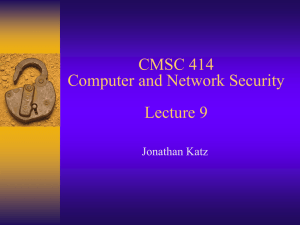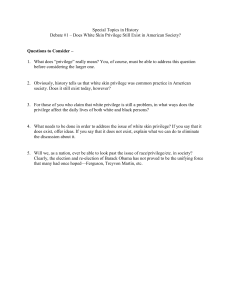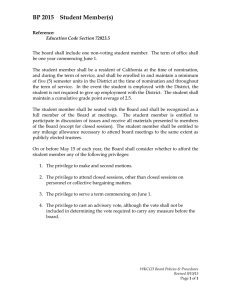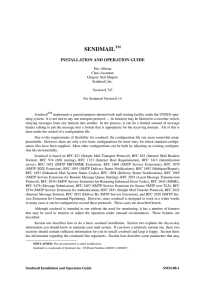CMSC 414 Computer (and Network) Security Lecture 14 Jonathan Katz
advertisement
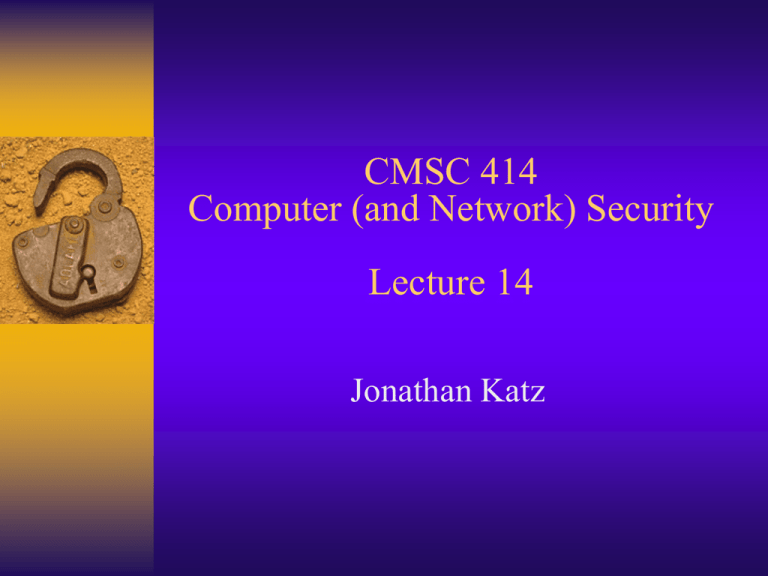
CMSC 414 Computer (and Network) Security Lecture 14 Jonathan Katz Midterm Review Design Principles (Chapter 13) Overview Eight principles underlying design and implementation of security mechanisms Described in an article by Saltzer and Schroeder (1975) – Still generally applicable today! Key point I Simplicity – Make designs/mechanisms easy to understand – Less chance of error – Example: (potentially) faulty implementation of sendmail – Example: (potential) inconsistencies in security policy Key point II Restriction – Minimize the “power” of an entity • E.g., only allow access to information it needs • E.g., only allow necessary communication; restrict type of communication allowed – Less chance of harm! Principle 1 “Principle of least privilege” – A subject should be given only the privileges it needs to accomplish its task – The function of a subject (not its identity) should determine this • I.e., if a subject needs certain privileges only to complete a specific task, it should relinquish those rights upon completion of the task In practice… Systems are often not designed with the necessary granularity – E.g., “append” may not be distinct from “write” – E.g., in UNIX, no access controls for root • Anyone who can make backup files can also delete files Principle 2 “Principle of Fail-Safe Defaults” – Unless a subject is given explicit access to an object, it should be denied access – I.e., the default is no access – E.g., a process reporting an error message should not try to expand its rights in an attempt to correct the error Principle 3 “Economy of Mechanism” – Security mechanisms should be as simple as possible… – …but no simpler! Consequences If design/implementation are simple, less chance for error Software testing is also simpler Software interfaces especially suspect – Typically make assumptions about the input/output format of the other module – E.g., finger protocol Principle 4 “Principle of Complete Mediation” – All accesses to objects should be checked to ensure they are allowed – OS should mediate any request to read an object --- even on the second such request by the same subject! Insecure examples… – In UNIX, when a process tries to read a file, the system checks access rights – If allowed, it gives the process a file descriptor – This file descriptor can be presented to the kernel for access – Note that if permissions are subsequently disallowed, the process still has the valid file descriptor! • Insufficient mediation Principle 5 “Open Design” – No “security through obscurity” – Security of a system should not depend on the secrecy of its implementation • Of course, secret keys do not violate this principle! Principle 6 “Separation of Privilege” – A system should not grant permission based on a single condition – E.g., require more than one sys admin to implement a critical command Principle 7 “Principle of Least Common Mechanism” – Minimize mechanisms depended upon by all users – Shared mechanisms are a potential information path, and should not compromise security – Any mechanism serving all users must satisfy all users, a difficult task to achieve… Principle 8 “Psychological Acceptability” – Security mechanisms should not make access to the resource more difficult – If mechanisms are too cumbersome, they will not be used! – Even if they are used, they may be used incorrectly – Password example… Principles in Practice Some terminology Trojan horse: program that appears to do something useful, while in fact doing something malicious Virus: program that copies itself into other (local) programs Worm: program that copies itself over computer networks, infecting programs/machines in remote locations Morris worm (1988) Exploited buffer overflow flaw in fingerd Also exploited flaw in sendmail – Sendmail had root privilege when run in debug mode Spread by guessing user passwords(!) (Some) lessons? Complex programs (like sendmail) have bugs – Such programs should not run with high privileges (i.e., root) Violations of principles? – Principle of least privilege – Separation of privilege – Others? Melissa virus/worm (1999) Word macro… – When file opened, would create and send infected document to names in user’s Outlook Express mailbox – Recipient would be asked whether to disable macros(!) • If macros enabled, virus would launch (Some) lessons? Violations? – Psychological acceptability (should users have to decide whether to enable macros?) – Principle of least privilege – Open design? – Others? Chernobyl virus (1998) When infected program run, virus becomes resident in memory of machine – Rebooting does not help Virus writes random garbage to hard drive Attempts to trash FLASH BIOS – Physically destroys the hardware… (Some) lessons? Violations? – Least privilege (why should the average user ever need to write to the BIOS?) – Fail-safe defaults – Complete mediation – Etc.
